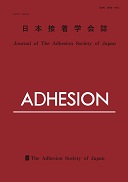
- |<
- <
- 1
- >
- >|
-
Kiyotaka OBUNAI, Takuya MATSUMOTO, Tadao FUKUTA, Koichi OZAKI2017Volume 53Issue 6 Pages 217-222
Published: June 01, 2017
Released on J-STAGE: September 20, 2018
JOURNAL FREE ACCESSDownload PDF (4555K)
-
Koki ITOKAWA, Kazuya OKUBO, Toru FUJII2017Volume 53Issue 6 Pages 210-216
Published: June 01, 2017
Released on J-STAGE: September 20, 2018
JOURNAL FREE ACCESSDownload PDF (4400K)
-
Yoshinobu NAKAMURA, Takuya MATSUMOTO, Ken-ichi MIYAZAKI, Ryota TSUTSU ...2017Volume 53Issue 6 Pages 202-209
Published: June 01, 2017
Released on J-STAGE: September 20, 2018
JOURNAL FREE ACCESSThe thickness of interfacial layer of a model incompatible polymer blend system was analyzed using1H pulse nuclear magnetic resonance (pulse NMR) spectroscopy. For this purpose, non-crosslinked andcrosslinked poly(n-butyl methacrylate) (PBMA) particles with a mean size of ca. 0.9 μm were prepared byseeded emulsion polymerization, and the degree of crosslinking was varied. The particles were dispersed inpoly(vinyl chloride) (PVC) by melt blending. Dynamic mechanical analysis indicated that the non-crosslinkedparticles were completely compatible. In contrast, mutual diffusion of the polymer chains was restricted withinthe particle/matrix interfacial layer for crosslinked particles. As a result, model incompatible phase structurewas formed. Dynamic mechanical analysis indicated that the composite has four phases of PVC (A), PBMA(B), PBMA in which molecular mobility was restricted by crosslinking point (C) and interfacial layer (D). Theproton ratio for these phases was measured by pulse NMR. The interfacial layer thickness was calculated fromthe proton ratio under the assumption that the dispersed phase is consisting of B, C and D and the addedparticle is consisting of B and C. The calculated thickness was in the range of 17 to 98 nm. The thicknessdecreased with an increase in the degree of crosslinking in the particles. The interfacial layer thickness in theparticles was approximately 10 times larger than that for the incompatible polymer pair.
View full abstractDownload PDF (5020K)
-
Shota KAWASAKI, Yu SEKIGUCHI, Gosuke NAKAJIMA, Kosuke HARAGA, Chiaki S ...2017Volume 53Issue 6 Pages 192-201
Published: June 01, 2017
Released on J-STAGE: September 20, 2018
JOURNAL FREE ACCESSFor stress relief in the adhesive layer, various methods have been proposed, including the use of scarf joints.However, these techniques are highly dependent on the adherend thickness and are thus of limited use. Thestress concentration of the joints can be relaxed by using mixed adhesive joints (MAJs), which employ a brittleadhesive in the middle portion of the overlap and a ductile adhesive at the bondline ends. In a previous paper,we proposed a manufacturing method of adhesive joints that have a variable modulus adhesive layer. Whenusing the proposed method, adhesive flow has a significant effect on the adhesive layer property distribution.Considering adhesive flow using finite element analysis or numerical analysis is difficult. Therefore, anexperimental evaluation is necessary to elucidate the actual behaviors of these joint types.The principal aim of this study was to investigate the relationship between applied patterns of brittle andflexible adhesives and the stress distributions of those adhesive layers. Accordingly, stress distributions ofsingle lap joints were evaluated by a tensile test using a digital image correlation (DIC) method. Based on theDIC results, MAJs contributed to the relaxation of the adhesive layer stress concentration. According to theresults of the adherend strain distribution, the longer was the soft type of adhesive, the wider was the stressconcentration area.
View full abstractDownload PDF (5426K)
- |<
- <
- 1
- >
- >|